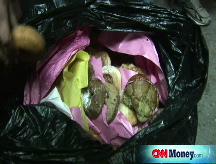Food banks: 30% rise in needy
Long lines at food pantries due to rising unemployment and food costs have pushed resources to the limit. But a stimulus plan may not go far enough.
 |
| Volunteer Cherise Barthalow tracks groceries donated to a Memphis agency. |
NEW YORK (CNNMoney.com) -- In his Senate confirmation hearing Wednesday, Treasury Secretary nominee Tim Geithner told a sobering story about the economy, talking of a severe recession that has cost the nation millions of jobs.
He also mentioned a sobering anecdote.
"At the food bank where my wife and son volunteer, the lines are long and getting longer," Geithner said.
Nationwide, food banks are reporting a 30% increase in the number of people seeking assistance -- double the increase reported just six months ago, according to Feeding America, a network of more than 200 food banks across the country. The organization says food banks serve 25 million Americans of the 35 million it estimates are in need of food banks's services.
As a result of growing demand, 72% of food banks have been unable to adequately meet needs, resulting in cut backs in the amount of food they make available to pantries that serve food.
"Millions of Americans simply don't have enough money to buy food," said Ross Fraser, spokesman for Feeding America. "We're seeing the needle moving up in terms of how much people make that come to food pantries."
Food pantries noted that an increasing number of people coming to food banks have recently lost jobs.
"More and more people are coming to us and saying they've lost their jobs," said Jean Warren, executive director of Lutheran Community Services in Wilmington, Del. "People are making choices between paying their gas bill or buying food."
Many food banks and pantries have been forced to give out less food or limit how many times individuals can come in a given week, according to Stacy Dean, director of food assistance policy at the Center for Budget and Policy Priorities.
Some have even gone to extreme measures, including one food bank in Florida that sold the van it used to deliver food in order to raise money to buy more food.
Warren noted that her organization, which served about 68,000 people last year at 11 locations throughout Delaware, spent its entire 2008 food budget by August. The group had to begin deficit spending until it began to receive more private donations after an appeal.
Rising food costs have also contributed heavily to the problem. Although general inflation has shifted into reverse recently and food price inflation has moderated in the past few months, food costs still rose 5.9% in 2008 - the highest increase of any category the government tracks, according to the U.S. Department of Labor.
Prices of staple foods like corn, wheat and other grains have grown especially rapidly - up 11.7% in 2008. As a result, many hungry Americans are turning to less expensive food, which tends to lack the nutrition available in pricier foods.
"Food prices have gone sky high in the past year, and haven't come down," said Fraser. "People who we always served are more hurt than ever, and there is a new class of people coming in who are in need of help for the first time."
The problem is not a new one. Even earlier in 2008, when the economy was bad but not nearly in the crisis that it finds itself in now, food banks noticed longer lines due to rising food costs and fuel prices.
Economists say government help for food banks is crucially important, because they can help needy Americans that most government programs can't reach.
"Most money from taxes doesn't reach the people who are most in need," said Bob Brusca, economist with FAO Economics. "It's very hard to reach those people."
As a result, the U.S. Department of Agriculture provides food banks with $250 million a year through a program called The Emergency Food Assistance Program. The program provides food banks with money to buy food, and it sends them bonus crops -- extra crops that had a surprisingly good year that farms can't otherwise sell or store.
Still, the vast majority of food banks' funds come from private donations, both from food suppliers and gifts from individuals and businesses.
But food banks say that won't be enough this year.
"When people have less money to give, things can dry up," said Dean.
One government program that could possibly help, the Obama stimulus plan being debated in Congress, would dedicate $20 billion to increase food stamp benefits by over 13%. That would help defray the costs to hungry Americans and food banks alike, as people in need would receive extra cash to buy food on their own. ![]()


